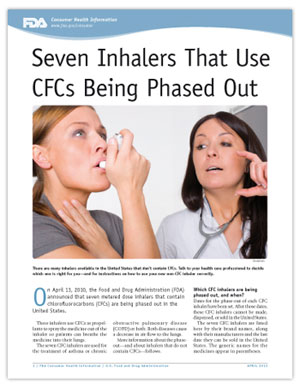Seven Inhalers That Use CFCs Being Phased Out
On April 13, 2010, the Food and Drug Administration (FDA) announced that seven metered dose inhalers that contain chlorofluorocarbons (CFCs) are being phased out in the United States.
These inhalers use CFCs as propellants to spray the medicine out of the inhaler so patients can breathe the medicine into their lungs.
The seven CFC inhalers are used for the treatment of asthma or chronic obstructive pulmonary disease (COPD) or both. Both diseases cause a decrease in air flow to the lungs.
More information about the phase-out—and about inhalers that do not contain CFCs—follows.
Which CFC inhalers are being phased out, and when?
Dates for the phase-out of each CFC inhaler have been set. After those dates, these CFC inhalers cannot be made, dispensed, or sold in the United States.
The seven CFC inhalers are listed here by their brand names, along with their manufacturers and the last date they can be sold in the United States. The generic names for the medicines appear in parentheses.
- Tilade Inhaler (nedocromil), made by King Pharmaceuticals, last date for sale: June 14, 2010
- Alupent Inhalation Aerosol (metaproterenol), made by Boehringer Ingelheim Pharmaceuticals, last date for sale: June 14, 2010
- Azmacort Inhalation Aerosol (triamcinolone), made by Abbott Laboratories, last date for sale: Dec. 31, 2010
- Intal Inhaler (cromolyn), made by King Pharmaceuticals, last date for sale: Dec. 31, 2010
- Aerobid Inhaler System (flunisolide), made by Forest Laboratories, last date for sale: June 30, 2011
- Combivent Inhalation Aerosol (albuterol and ipratropium in combination), made by Boehringer Ingelheim Pharmaceuticals, last date for sale: Dec. 31, 2013
- Maxair Autohaler (pirbuterol), made by Graceway Pharmaceuticals, last date for sale: Dec. 31, 2013
Four of the seven CFC inhalers are no longer being made. Three CFC inhalers currently in use—Aerobid, Combivent, and Maxair—will be phased out over the next one to three years. These later phase-out dates give patients time to talk with their health care professionals and switch to another medicine.
FDA will continue to reach out to companies, health care professionals, and patients to ensure a smooth transition.
What should I do if I use one of the seven CFC inhalers being phased out?
If you use one of these CFC inhalers, talk with your health care professional and switch to a medicine that does not contain CFCs. You cannot be sure how long you will be able to buy your CFC inhaler because manufacturers may stop making them before the last day they can be sold. For example, the manufacturers of Alupent Inhalation Aerosol and Tilade Inhaler have already stopped making these drugs.
If you have an inhaler after the last day the inhaler can be sold, you may continue to use it.
Why are CFC inhalers being phased out?
CFCs harm the environment by decreasing the ozone layer above the earth. The ozone layer protects us from harmful ultraviolet radiation.
The United States and most other countries have signed an international agreement to make it illegal after certain dates to manufacture or sell substances, including CFCs, which decrease the ozone layer.
Most CFC inhalers have already been phased out as part of this agreement.
What other medicines can I use for my asthma or COPD?
There are many other inhalers available in the United States that don’t contain CFCs. Talk to your health care professional to decide which one is right for you.
To see some of the FDA-approved treatments for asthma and COPD, visit the FDA Web page “Drug Treatments for Asthma and Chronic Obstructive Pulmonary Disease that Do Not Use Chlorofluorocarbons.”
FDA will work with companies to ensure enough other medicines are available.
How will the other medicines differ from the CFC inhaler I am using?
There are inhalers that use the propellant hydrofluoroalkane, or HFA, instead of CFCs. There are also dry powder inhalers that don’t use a propellant at all, and liquids that are used with a nebulizer machine.
These medicines to treat your asthma or COPD may look, feel, or taste different, and may be used differently than your CFC inhaler.
Ask your health care professional to show you how to use your new medicine correctly.
What can I do if I cannot afford the medicine that is prescribed?
- Talk to a health care professional about programs that can help get the medicine you need.
- Check with the company that makes the medicine to see if it has a patient-assistance program that provides the medicine at no cost, or at a lower cost.
- Check with the Centers for Medicare & Medicaid Services (CMS) to see if they can provide help in paying for the medicine.
Is it safe to buy the replacement for my current inhaler over the Internet?
When it comes to buying medicine online, it is important to be careful. Some Web sites sell medicine that may not be safe to use and could put your health at risk.
For more information, read "Buying Prescription Medicines Online: A Consumer Safety Guide."
How can I find out more about the phase-out?
For more information about the phase-out of these seven CFC inhalers, and other CFC inhalers that already have been phased out, visit
- Phase-Out of CFC Metered-Dose Inhalers Containing flunisolide, triamcinolone, metaproterenol, pirbuterol, albuterol and ipratropium in combination, cromolyn, and nedocromil
- Phase-Out of CFC Metered-Dose Inhalers
This article appears on FDA's Consumer Updates page, which features the latest on all FDA-regulated products.
Date Posted: April 13, 2010
Return to FDA Consumer Articles

